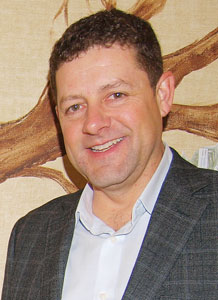The 2013 provincial budget has left few groups untouched, with many seeing considerable drops in funding. School divisions are among those feeling the budget crunch.
Golden Hills School Division is looking at a drop in funding of at least 2.5 per cent.
“We are currently working through the budget. At this stage, we certainly have less money to work with this year,” said Bevan Daverne, superintendent of Golden Hills. “There is definitely going to be an impact for us. We don’t know what exactly yet, but we are looking at a drop of at least 2.5 per cent compared to last year. That doesn’t include whatever the settlement with teachers will be.”
Both Golden Hills and Prairie Land Regional Division have started going through their respective budgets to see where cuts can be made.
“We’re starting the work already to go through our budget with a fine-toothed comb,” said Daverne. “There are still a number of things we haven’t digested yet. We’re working through it.”

Bevan Daverne, superintendent of Golden Hills School Division discusses provincial budget cuts with The Mail.
Prairie Land’s board will discuss the budget at the March 20 board meeting.
“When you consider the cost of increases in salaries, we’re going to have to sit down and think about what we need to do to balance the budget or live within reserves,” said Sharon Orum, secretary-treasurer of Prairie Land.
Perhaps one of the biggest hits faced by both divisions is the elimination of Alberta Initiative for School Improvement (AISI) funding.
“AISI funding was cut, which, for us, was a pretty big deal. It was the mechanism we used to drive change in our district,” said Daverne. “Even without AISI, we want to continue our work on school improvements and changes to the classroom.”
Orum said, without AISI, professional development would be reduced.
“Our project was to offer professional development opportunities and create learning coaches for 21st century learning. We’ve had to stop those programs, because of these cuts. We’ll be looking at other ways to deliver professional development,” said Orum.
Additional cuts affect operations and building maintenance.
The cuts come at a time when both school divisions were already running with tight budgets.
“We’ve had to run a tight budget for the last few years. When they transitioned from a rural stabilization formula a few years ago, we really had to look hard at making reductions,” said Orum. “It’s not going to be an easy budget again and it hasn’t been for the last few years.”
In the end, both divisions pledged to work hard to keep the cuts from affecting the classroom.
“Our first priority is to protect the classroom as much as we can, but 2.5 per cent is not a small cut. We don’t yet know what the impact will be, but we will try to mitigate and make it as small as possible,” said Daverne. “We have some challenges ahead of us, but, at the end of the day, we want to work for the best interests of our kids.”
 Wheatland County is helping its residents protect one of the area’s most precious resources; its water.
Wheatland County is helping its residents protect one of the area’s most precious resources; its water.



























